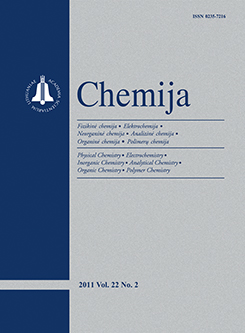Chemija / Chemistry
 ISSN 0235-7216 ISSN 2424-4538 (online) |
2013 m. Nr. 3 Removal of the phthalocyanine dye from acidic solutions
using resins with the polystyrene divinylbenzene matrix
Two resins of polystyrene divinylbenzene matrix: the macroporous strong base Purolite A 500PS anion exchanger and hypercrosslinked non-functionalized Macronet MN 200 were proofed as suitable adsorbents for the removal of hazardous copper phthalocyanine dye – Acid Blue 249 (CuPc). The sorption isotherms and kinetics of CuPc in acidic aqueous solutions were investigated using batch experiments. The resins surface texture was evaluated using a scanning electron microscope. The FTIR study of unloaded and CuPc dye loaded resins identified the functional groups of resins and dye anion and the specific sorption mechanisms: ion exchange in participation of the protonated quarternary amino groups of Purolite A 500P and the electrostatic interaction in participation of the fenolic groups of Macronet MN 200. The kinetic data were correlated with intraparticle diffusion and the pseudo-second order kinetic equations. The activation energies such as intraparticle diffusion (Ea–ki) and chemical sorption (Ea–k2) were calculated using the Arrhenius relationship. The CuPc dye sorption on Purolite A 500PS is limited by the intraparticle diffusion, whereas sorption on Macronet MN 200 is limited by the intraparticle diffusion depending on pore size distribution and on the boundary layer thickness. Purolite A 500PS is substantially more effective for the sorption of CuPc dye than Macronet MN 200. The amount of CuPc dye sorbed at equilibrium on Purolite A 500PS and on Macronet MN 200 was 86.9 μmol/g and 2.3 μmol/g, respectively.
Keywords: sorption, polymeric sorbent, copper phthalocyanine dye, kinetic * C |
Issues:
2017 - Vol.28 No. 1, No. 2, No. 3, No. 4 2016 - Vol.27 No. 1, No. 2, No. 3, No. 4 2015 - Vol.26 No. 1, No. 2, No. 3, No. 4 2014 - Vol.25 No. 1, No. 2, No. 3, No. 4 2013 - Vol.24 No. 1, No. 2, No. 3, No. 4 2012 - Vol.23 No. 1, No. 2, No. 3, No. 4 2011 - Vol.22 No. 1, No. 2, No. 3, No. 4 2010 - Vol.21 No. 1, No. 2-4 2009 - Vol.20 No. 1, No. 2, No. 3, No. 4 2008 - Vol.19 No. 1, No. 2, No. 3-4 2007 - Vol.18 No. 1, No. 2, No. 3, No. 4 2006 - Vol.17 No. 1, No. 2-3, No. 4 2005 - Vol.16 No. 1, No. 2, No. 3-4 2004 - Vol.15 No. 1, No. 2, No. 3, No. 4 2003 - Vol.14 No. 1, No. 2, No. 3, No. 4 2002 - Vol.13 No. 1, No. 2, No. 3, No. 4 2001 - Vol.12 No. 1, No. 2, No. 3, No. 4 |